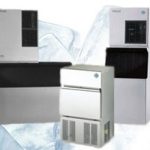

Ice makers: the shape of things to come
The hunt is definitely on for crystal clear ice. Teenagers drinking cola out of paper cups love ice but aren't fussy what it looks like, as long as they can crunch it up afterwards. However, high end bars and restaurants want their ice crystal clear. Often, they combine this requirement with wanting a machine that produces larger cubes.
If you use a freezer to make ice, it tends to produce cloudy cubes. People have tried to get around this in different ways, by boiling the water for example, or employing distilled water, or using melted ice water. These methods don't work because strangely enough, it's not the clarity of the water that tends to decide the clarity of the ice - it's the amount of air trapped in the ice.
So people (and manufacturers of ice makers) have experimented with the freezing part of ice making. For example, slow freezing so that the air can escape as the ice freezes, or freezing the ice top downwards in a container that is insulated. The bottom layer is cloudy, and you discard it. However, these methods aren't really practical for commercial catering and bar companies.
Round the block
Some New York bars have been buying ice in 300 pound blocks from ice sculpture companies and chopping it up into different shapes, in order to get totally clear ice. Artisan ice, if you like. Now, bars are even demanding ice with their logo on each cube. Again, this is unlikely to be something you'll see at a racetrack bar on a summer's day, but the ice machine makers need to be aware of these transatlantic trends, as they have a habit of crossing the ocean and turning up here.
You can get ice making machines that use filtered water to achieve clear ice, so clarity is definitely achievable
More shapes, please
There's a distinct feeling in the industry that cubes are a bit corporate. Hoshizaki make a round ice ball maker, but when you look at the industrial machines, as efficient, productive and energy saving as they are, they tend to focus on function rather than form.
While the drinks industry has been a riot of innovation, with new tastes, flavours, mixes and types of drink appearing constantly, ice has to date been a bit unremarkable. At the moment, the programmable features on most machines don't include the ability to produce different shapes of ice. Maybe this will be where ice maker technology merges with 3-D printing to produce a cross between a printer and an icemaker.
And finally - an ice teaser
However, any kind of ice will do to settle an argument about melting ice and sea levels. Fill a glass with ice cubes then fill it up to the brim with water. As the ice melts, will the water overflow the glass? This is the point at which you can start taking bets from your less well-informed friends - try it for yourself.


Validate your login
Login
Create New Account